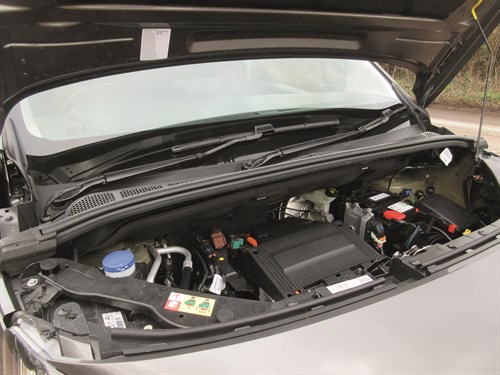- Orders open for Ineos Grenadier Commercial
- Toyota Hilux range gains new rally-inspired GR Sport II variant
- Remarketing: Pick of the bunch
- GA Commercial acquires first vans through Vanaways
- 'Luxury' tax on expensive pick-up trucks suggested
- ADVERTISEMENT FEATURE: Essential advice to avoid the van fleet ICE-berg
- ETRUX launches new Ford E-Transit Trizone
- Renault gives UK debut to Master E-Tech at CV Show
- Isuzu D-Max long-term test – Latest Report
- Isuzu D-Max V-Cross Steel Edition revealed
The What Van? Road Test: Toyota Proace City Electric (2021)
Date: Monday, April 11, 2022

Powertrain
City Electric’s 454v permanent magnet synchronous motor delivers up to 260Nm of torque and its transmission functions in the same way that an automatic gearbox does.
Buyers can specify either a 7kW single-phase or a 11kW three-phase OBC (on-board charger)
The former enables you to charge up the battery in 7.1 hours if you plug the van into a wallbox. Our van was equipped with the 11kW OBC, which cuts the charging time to 4.5 hours assuming that you have access to a three-phase supply.
Whichever on-board charger you have, if you connect the van to a public or business 100kW DC fast-charger then the battery will make its way back up to 80% of its capacity in half-an-hour, says Toyota. Plug it into a domestic three-pin socket, however, and it will take a tedious 30.5 hours to get it from 0% to 100%.
With 216 cells organised in 18 modules, the battery uses a glycol water-cooling system.
The charging point is on the nearside of the van’s body close to the rear doors in both cases. Type 2 cables for connection to a domestic power supply or a wallbox are included in the deal.
Driving
Proace Electric is easy to operate. Rather than a gear lever, you are faced with a switch – Toyota calls it an e-toggle – on a console in front of the dashboard that lets you choose reverse, neutral or drive. It could not be simpler, and you can be on your way once you have released the electronic parking brake.
The only other thing to consider is which drive mode you should select.
A button next to the e-toggle gives you the choice of eco, normal or power, with the motor’s power and torque adjusted in each case.
You use eco (60kW/180Nm) if you need to get the maximum mileage out of whatever charge is left in the battery.
Resorting to it means you will have to put up with a marked decline in performance. Acceleration is restricted, and you will find that your ability to keep up with traffic on the dual carriageway is limited.
Go to power (100kW/260Nm) instead, and you will be rewarded by a firm shove between the shoulder blades. It delivers strong acceleration, motorway cruising speeds are easily maintained, and overtaking is a doddle; but your range suffers accordingly.
Normal (80kW/210Nm) represents the happy medium, and is fine if all you are doing is pottering around the suburbs half-laden.
The cab takes a while to warm up no matter which setting you pick; and if you have decided to opt for eco on a winter’s day, then make sure you have got your thermals on.
Displays in the instrument panel tell you how much charge is left in the battery and how many more miles you can travel before you run out.
You can also see if you are recouping energy while driving.
A regeneration function captures energy that would otherwise be lost when, for example, you lift your foot off the accelerator pedal and coast downhill, and pumps it into the battery. Your range is boosted by several miles as a consequence.
To boost regeneration you press a button near the e-toggle.
While Proace Electric’s ride is not so great, especially when you are travelling across uneven road surfaces unladen, there is no denying that it handles well. In-cab noise levels are of course minimal; apart from the slap of the tyres on the highway.
View The WhatVan Digital Edition


